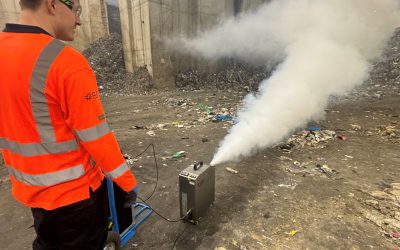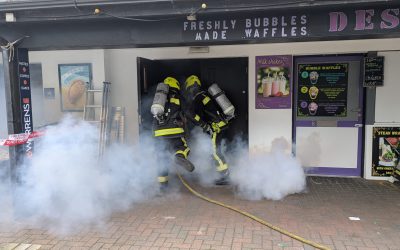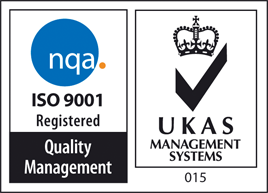High Temperature Smoke Training – The Way Forward?
Oil-based smokes allow firefighter training to be carried out in conjunction with hot fire training, and also offer advantages over conventional water-based systems in unheated chambers, argues Trevor Dunnington.
One of the UK's most sophisticated fire simulators, a Royal Navy “Technology Demonstrator” training module which can simulate shipboard fire scenarios, uses a non-flammable artificial training smoke system capable of providing realistic coverage even in high temperatures.
The Navy Demonstrator incorporates a series of sensor-controlled LPG burners with flame height which can be modulated in response of firefighting teams. Whilst LPG offers precise control over the flames required for each scenario, the gas burnt “cleanly”, and so the UK Ministry of Defence MOD needed to find a realistic training smoke that would withstand temperatures well in excess of 100 Degrees Celsius.
Conventional water-based smoke simulations (made up in the main of various glycols and glycerol), effective (though expensive in running cost terms) in unheated environments, proved unsuitable to this application.
As the temperature within a room filled with water-based smoke increases, a clear layer (above which the smoke will not persist) forms at the 40 – 45 Degrees Celsius thermal for most glycol-based systems, and no higher than 70 Degrees Celsius for glycerol based systems.
To achieve the desired non-flammable, temperature-resistant, the Royal Navy eventually chose a system using a food-quality, refined white oil. The oil is entrained in a stream of inert propellant gas prior to the heating of the oil to vapour state, and a dense, oil based smoke (more accurately described as a fog or aerosol), of a very small particulate size (0.22u mass median diameter) was formed, still entrained in inert gas. Subsequent test at the Demonstrator proved that the resulting oil-based smoke met the MOD's initial requirement with regard to temperature resistance, and practical trials of the systems within the Demonstrator began in earnest in 1990.
Hot Fire Smoke
Following the successful development of the smoke generator system to fulfill the MOD's training requirement, the UK company involved, Concept Engineering, brought out an oil-based, maintenance free, high temperature smoke generator for the commercial sector. Using a state of the art digital temperature module, solid state switching, calibrated sight glass and a completely new heat exchanger vaporisation chamber, the ViCount Compact was officially launched in 1993.
This produced a smoke which was chemically identical to that used by the MOD's generator, but in much larger volumes.
Oil Based Vs. Water Based?
Developed mainly because of its very high resistance to elevated temperatures, in-house trails of the oil based smoke systems against water based smoke generators indicated some dramatic benefits to users of training smoke – even in unheated chambers.
The oil based smoke could achieve equivalent smoke densities to water based systems, for a fraction of the concentration of chemical in the air. To achieve the same smoke density, as little as a quarter the amount of smoke oil in the atmosphere was required to achieve the same visibility through the smoke.
This dramatic difference in concentration becomes even more pronounced when comparing the oil based smokes with the less persistent glycols. While this particular oil based system was produced to meet a requirement for a training smoke which was resistant to high temperatures, it quickly became apparent that brigades which were heavy users of water based smoke fluids, even in unheated chambers, could also benefit from lower running costs and enhanced smoke quality, by converting to oil based systems.
How Toxic is Oil Based Smoke?
Oil based smoke has undergone extensive testing by numerous bodies, including the UK's Health and Safety Executive as well as by independent laboratories to ensure the smoke is as safe (or safer) than water based alternatives. For their own benefit, the MOD also conducted their own analyses into the smoke at their training site, into both the toxicity and flammability.
In brigade “hot fire” training situation however, where the source of the fire is often a crib stacked with pallets, products of combustion are present, and in situations such as these breathing apparatus should be worn as a matter of course, whether artificial smoke is present or not.






